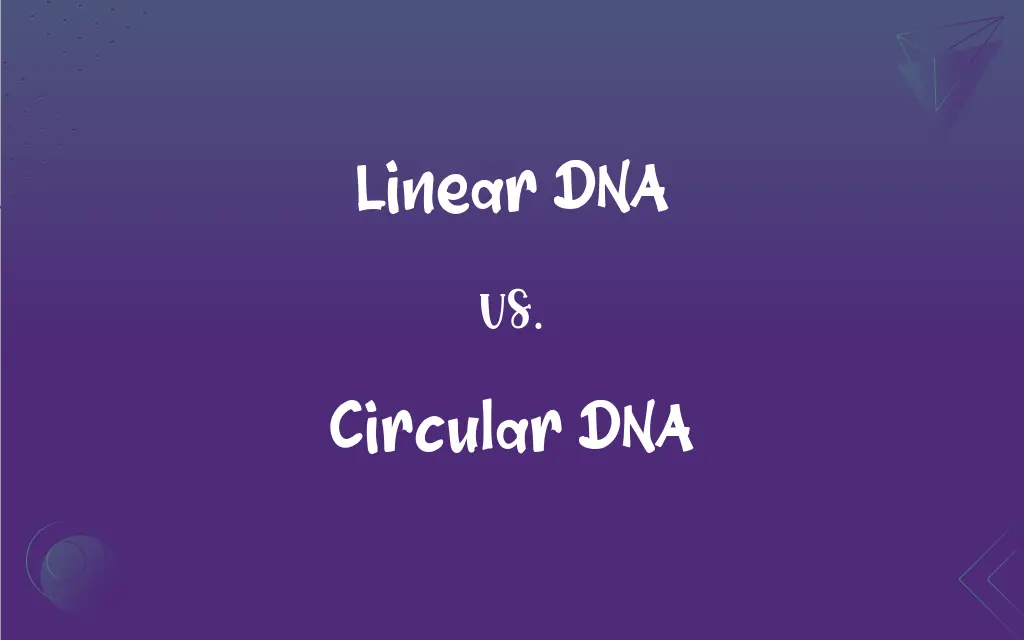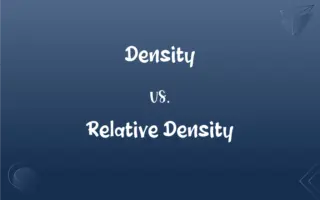Linear DNA vs. Circular DNA: What's the Difference?
Edited by Aimie Carlson || By Harlon Moss || Published on February 29, 2024
Linear DNA consists of two ends and is typically found in eukaryotes, while circular DNA forms a closed loop and is common in prokaryotes.

Key Differences
Linear DNA, characterized by its straight structure with two distinct ends, is primarily found in eukaryotic cells, such as those of humans and plants. Circular DNA, which forms a continuous loop without ends, is typically found in prokaryotic cells, like bacteria, and in the mitochondria and chloroplasts of eukaryotic cells.
In linear DNA, the presence of telomeres (repetitive nucleotide sequences) at each end protects the DNA from damage or fusion with other chromosomes. Circular DNA lacks these telomeres, as its circular nature inherently protects the ends of the genetic sequence.
Replication of linear DNA often leads to the shortening of telomeres, posing a challenge for cell division and aging. Circular DNA does not face this issue, allowing many prokaryotes to replicate rapidly and efficiently.
The organization of genes in linear DNA is complex, often interspersed with non-coding regions and tightly regulated. In contrast, circular DNA usually contains fewer non-coding regions and a simpler organization, facilitating quicker transcription and replication.
Linear DNA is packed into chromosomes within the cell nucleus, a feature associated with the complex cellular organization of eukaryotes. Circular DNA, found in prokaryotes, typically resides in a nucleoid region, reflecting the simpler cell structure of these organisms.
ADVERTISEMENT
Comparison Chart
Shape and Structure
Long, double-stranded with ends
Closed loop, no free ends
Location
Eukaryotic cells (nucleus)
Prokaryotic cells, mitochondria, and chloroplasts
Telomeres
Present at ends
Absent
Replication and Aging Concerns
Telomere shortening issues
No telomere shortening
Genetic Organization
Complex with non-coding regions
Simpler, fewer non-coding areas
ADVERTISEMENT
Linear DNA and Circular DNA Definitions
Linear DNA
DNA with two free ends, organized into chromosomes.
Human cells contain linear DNA packed into 23 pairs of chromosomes.
Circular DNA
Found in simpler, often single-celled organisms.
Circular DNA is a key feature of the simpler cellular structure of prokaryotic organisms.
Linear DNA
Characteristic of eukaryotic cells, with complex gene regulation.
The linear DNA in plant cells undergoes intricate processes for gene expression.
Circular DNA
DNA that forms a closed loop, common in prokaryotes.
Bacterial cells contain circular DNA, which enables rapid replication.
Linear DNA
Longer DNA molecules organized in a linear fashion.
Linear DNA in eukaryotes is responsible for storing a vast array of genetic information.
Circular DNA
A closed-loop DNA molecule without free ends.
Plasmids, which are circular DNA, can transfer genes between bacteria.
Linear DNA
Contains telomeres to protect its ends during replication.
Aging in human cells is partly attributed to the shortening of telomeres in linear DNA.
Circular DNA
Lacks telomeres and is often found in mitochondria and chloroplasts.
The mitochondria in human cells have their own circular DNA.
Linear DNA
Typically found in the nucleus of eukaryotic cells.
In eukaryotic cells, linear DNA resides within the cell's nucleus.
Circular DNA
Characterized by a simpler organization for efficient transcription.
Circular DNA in bacteria allows for quick genetic transcription and cell division.
FAQs
What is circular DNA?
DNA in a closed-loop form, without free ends, found in prokaryotes and organelles.
What is linear DNA?
DNA with a linear structure, having two ends, typical in eukaryotic cells.
Where is circular DNA commonly found?
In prokaryotic cells like bacteria, and in mitochondria and chloroplasts.
How does replication differ in linear and circular DNA?
Linear DNA faces telomere shortening, while circular DNA does not.
Can linear DNA be found in bacteria?
Typically, no. Bacteria usually have circular DNA.
What are telomeres in linear DNA?
Protective repetitive sequences at the ends of linear DNA.
Does circular DNA have telomeres?
No, it lacks telomeres due to its continuous loop structure.
How do cells protect linear DNA from damage?
Through telomeres at the ends of the DNA, which protect against degradation.
Is gene organization different in linear and circular DNA?
Yes, linear DNA is more complex with non-coding regions, while circular DNA is simpler.
Can circular DNA be transferred between organisms?
Yes, especially in the form of plasmids in bacterial conjugation.
What role does circular DNA play in prokaryotes?
It houses most of the genetic information necessary for the organism's survival and reproduction.
Where is linear DNA found?
In the nucleus of eukaryotic cells, like those of humans and plants.
Is the replication of circular DNA faster than linear DNA?
Generally, yes, due to its simpler structure and fewer regulatory mechanisms.
How does aging relate to linear DNA?
The shortening of telomeres in linear DNA is linked to cellular aging and senescence.
Do eukaryotic cells contain circular DNA?
Yes, in organelles like mitochondria and chloroplasts, aside from their main linear DNA.
Can circular DNA in mitochondria affect human health?
Yes, mutations in mitochondrial circular DNA can lead to various mitochondrial diseases.
How do cells pack linear DNA into chromosomes?
Through proteins called histones, which help in winding the long DNA molecules into compact structures.
Does the presence of linear DNA indicate a more complex organism?
Typically, as linear DNA is associated with the complex cellular structure of eukaryotes.
Are there exceptions to the typical locations of linear and circular DNA?
Yes, certain viruses and organelles may contain DNA that deviates from the typical cellular norms.
Why is linear DNA more complex than circular DNA?
It has a more intricate structure with non-coding regions and various regulatory elements.
About Author
Written by
Harlon MossHarlon is a seasoned quality moderator and accomplished content writer for Difference Wiki. An alumnus of the prestigious University of California, he earned his degree in Computer Science. Leveraging his academic background, Harlon brings a meticulous and informed perspective to his work, ensuring content accuracy and excellence.
Edited by
Aimie CarlsonAimie Carlson, holding a master's degree in English literature, is a fervent English language enthusiast. She lends her writing talents to Difference Wiki, a prominent website that specializes in comparisons, offering readers insightful analyses that both captivate and inform.
































































